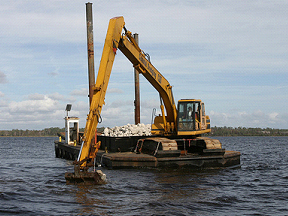The North Carolina Department of Transportation (NCDOT) has been working to integrate the concepts of sustainability into its decision-making and make the link between mobility and how it can better support communities and regions across the state. The effort has resulted in the articulation of eight principles with corresponding outcomes, objectives, and performance measures. The eight principles focus on: moving people and goods; choices; connectivity; resource protection; prosperity; accountability; healthy communities; and organizational responsibility.
The initiative began with an extensive review of sustainability plans across state departments of transportation. The purpose of the review was to identify and synthesize the best practices in integrating the concept of sustainability into transportation decision-making, with a specific emphasis on state DOTs that have developed documented plans and performance measures. Following this review, an internal NCDOT survey was conducted to identify existing sustainable practices and better understand how the department views the concept of “sustainability.”
Focus groups with agency staff and interviews with external stakeholders — including other state agencies, metropolitan planning organizations/regional planning organizations, councils of government, transit service providers, and private industry partners — were used to present and discuss the concept of sustainability, identify additional practices and initiatives that align with those concepts, and shape the subsequent principles and objectives that were the foundation of the framework. The department then identified metrics that would be used to assess consistency and progress in meeting outcomes associated with each of the principles.
Expanded Mission Statement
Integration of the concepts of sustainability are reflected in NCDOT’s newly expanded mission statement: “Connecting people and places safely and efficiently, with accountability and environmental sensitivity, to enhance the economy, health and well-being of North Carolina.” The Department’s mission was expanded and refined to recognize broadened responsibilities and aspirations, and now emphasizes a “triple bottom line” of enhancing economic development, human health and well-being, and environmental resource stewardship.
The principles have also been integrated into NCDOT’s statewide transportation plan (2040 Plan) and its draft 5-year and 10-year transportation improvement program (“Policy to Projects”). Efforts are also underway to evaluate project prioritization criteria and consider ways to integrate sustainability concepts in the project prioritization process.
The effort has culminated in the development of an “Accountability Framework” that links sustainability-related principles to key overarching plans and policies, strategies, and performance measures to monitor implementation progress and effectiveness over time. Further integration of these concepts into initiatives and decision-making is key to implementation. Other critical implementation elements include a communications plan, monitoring, and continuous improvement.
“Our goal from the start was to develop a viable framework for our department, and also document the methodology for its development, the mid-course adjustments, and lessons learned,” said Julie Hunkins, Manager of the Quality Enhancement Unit with NCDOT.
Sustainability at Work in North Carolina
A recent example of sustainability at work in NCDOT is the project to replace a 69-year-old bridge, which carries US 17 over the New River. As part of the project, NCDOT demolished the old bridge and donated nearly 8,000 tons of rubble, concrete, and metal to an effort by multiple state and local partners to build a new artificial reef in the New River near Jacksonville.

“This is a great way for NCDOT to live out its mission, which includes environmental sensitivity,” said NCDOT Assistant Resident Engineer Jimmy Zepeda, who is overseeing the bridge replacement project. “By reusing this material instead of putting it in a landfill, we helped form a vibrant habitat where aquatic life now lives and grows.” Recycling and reusing the material also saved the department as much as $590,000 in costs to dispose of the debris in a landfill.
More information on the NCDOT’s sustainability efforts and the Accountability Framework is available from Julie Hunkins at NCDOT, e-mail [email protected]. (Photo courtesy NCDOT)

